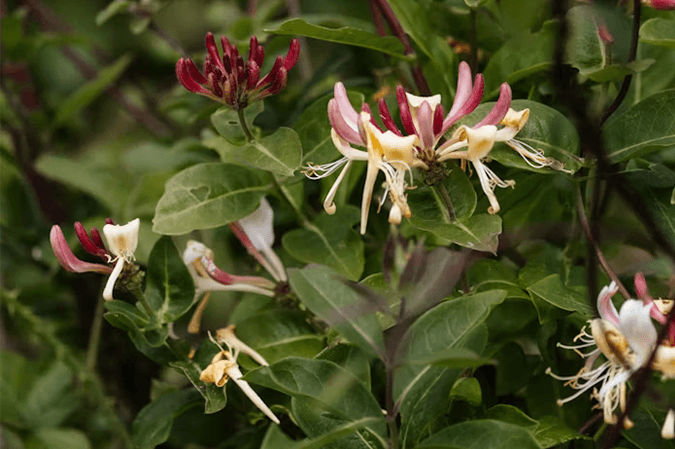Description
Honeysuckle refers to a group of flowering plants within the genus Lonicera in the family Caprifoliaceae. There are approximately 180 species of honeysuckle, which are native to the Northern Hemisphere, particularly in Asia, Europe, and North America. Honeysuckles are known for their sweetly scented, tubular flowers that produce a nectar attractive to pollinators. Depending on the species, honeysuckles can be deciduous or evergreen and may grow as shrubs or vines.
Common Features
- Leaves: Honeysuckle leaves are typically oval, with a smooth or slightly hairy texture, and are arranged oppositely along the stems. They are generally medium to dark green, although some species feature leaves with a bluish or grayish hue. In evergreen species, the leaves persist throughout the year, while in deciduous species, they drop in autumn.
- Flowers: Honeysuckle flowers are tubular, often bi-lobed, and grow in pairs. They come in a variety of colors, including white, yellow, pink, red, and orange. The flowers are known for their strong, sweet fragrance, which is particularly noticeable in the evening. The nectar-rich flowers are a favorite among hummingbirds, bees, and butterflies.
- Fruit: After flowering, honeysuckles produce small, berry-like fruits that can be red, orange, or black. While some species’ berries are edible, others can be toxic if ingested, particularly in large quantities.
- Growth Habit: Honeysuckles can grow as either twining vines or arching shrubs. Vining species, such as Lonicera japonica (Japanese honeysuckle), can climb structures or sprawl along the ground, making them useful for covering fences, trellises, or walls. Shrubby species, such as Lonicera tatarica (Tatarian honeysuckle), are often used in hedges or as standalone ornamental plants.
Role in the Ecosystem
- Pollinator Attraction: Honeysuckle flowers play a crucial role in attracting pollinators. Their sweet fragrance and nectar are particularly appealing to hummingbirds, bees, and butterflies, facilitating cross-pollination. This pollination helps maintain the health and diversity of the plant community.
- Wildlife Habitat: Honeysuckle plants provide shelter and food for various species of wildlife. The dense foliage offers cover for birds and small mammals, while the berries serve as a food source for birds, especially during the late summer and fall when other food sources may be scarce.
- Erosion Control: Certain vining species of honeysuckle, such as Lonicera japonica, are effective at controlling soil erosion on slopes and embankments due to their dense root systems and sprawling growth habit. However, this can also make them invasive in some regions.
Importance
- Ornamental Value: Honeysuckles are widely cultivated for their ornamental value in gardens and landscapes. Their fragrant flowers and attractive foliage make them popular choices for trellises, fences, and arbors. They are also used as ground covers and in hedges, adding aesthetic appeal to both formal and informal gardens.
- Medicinal Uses: Honeysuckle has been used in traditional medicine, particularly in Asia, for centuries. Lonicera japonica, known as Japanese honeysuckle, has been used in Chinese medicine to treat inflammation, infections, and fever. The flowers are often used to make teas or extracts believed to have antiviral, antibacterial, and anti-inflammatory properties.
- Cultural Significance: In various cultures, honeysuckle is associated with love, devotion, and the bonds of affection. The plant’s sweet fragrance and twining growth habit symbolize the intertwining of two lives, making it a popular motif in poetry and art.
Interesting Facts
- Invasive Species: Some honeysuckle species, particularly Lonicera japonica and Lonicera maackii (Amur honeysuckle), are considered invasive in parts of North America. They can outcompete native plants, leading to reduced biodiversity. Control measures are often necessary to manage their spread in affected areas.
- Historical Use: In medieval Europe, honeysuckle was often planted near homes and gardens, as it was believed to ward off evil spirits. The plant’s sweet fragrance was also used to freshen the air in homes before modern air fresheners were available.
- Edible Flowers: The flowers of some honeysuckle species, such as Lonicera caerulea (honeyberry), produce edible berries that are used in jams, jellies, and desserts. However, care must be taken, as the berries of many other species are toxic and should not be consumed.
Sources
- Royal Horticultural Society. (n.d.). Honeysuckle – Plant Finder. Retrieved from RHS
- Missouri Botanical Garden. (n.d.). Lonicera – Growing Guide. Retrieved from MBG
- University of Maryland Medical Center. (n.d.). Honeysuckle in Traditional Medicine. Retrieved from UMMC



